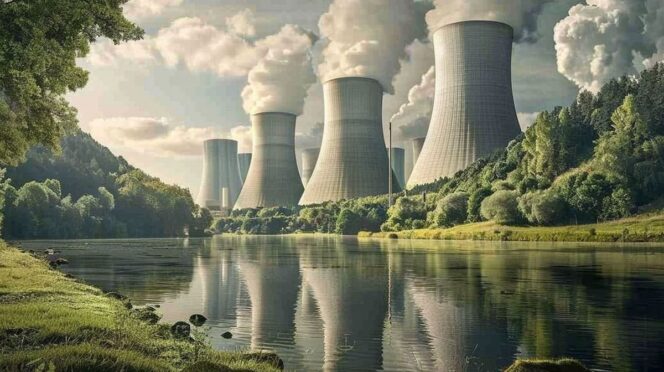Table of Contents Show
The uranium market is undergoing a significant transformation, driven by geopolitical events that are reshaping the global supply chain. The most notable development is the US ban on Russian uranium imports, which is set to create a seismic shift in the market and potentially lead to higher prices.
US Ban on Russian Uranium Imports
In a move aimed at reducing reliance on Russian nuclear fuel, the US has passed legislation banning Russian uranium imports from 2028-2040. The ban includes a potential 90-day waiver process in the interim, allowing for some flexibility in the short term.
The US nuclear industry currently relies on Russia for over 20% of its enriched uranium needs, making this ban a significant challenge for utilities. However, the government has taken steps to mitigate the impact by unlocking $2.7 billion in funding to support the expansion of domestic uranium enrichment capacity.
This funding is crucial for the development of a robust US nuclear fuel supply chain, as it will help to reduce the country’s dependence on foreign sources and ensure a stable supply of uranium for the growing fleet of nuclear reactors.
Utilities Diversifying Supply Sources
In response to the geopolitical risks associated with relying on Russian nuclear fuel, utilities are actively seeking to diversify their supply sources. This shift is expected to create additional demand for uranium from non-Russian sources, such as Canada, Australia, and Kazakhstan.
As utilities work to secure long-term supply contracts with alternative providers, the increased competition for limited supplies could put upward pressure on uranium prices. This trend is likely to accelerate as the US ban on Russian imports draws closer and utilities scramble to ensure a stable supply of fuel for their reactors.
The Growing Focus on Supply Chain Security
The uranium market is not alone in its focus on supply chain security. Across various industries, there is a growing recognition of the importance of reducing reliance on single sources of critical materials and diversifying supply chains to mitigate geopolitical risks.
In the nuclear industry, this focus on supply chain security is particularly acute, given the strategic importance of nuclear power in the global energy mix and its role in combating climate change. As countries around the world set ambitious targets for reducing greenhouse gas emissions, the demand for nuclear power is expected to grow, putting further pressure on the uranium supply chain.
To address these challenges, governments and industry players are investing in the development of domestic uranium mining and enrichment capabilities, as well as exploring new technologies and partnerships to strengthen the resilience of the global nuclear fuel supply chain.
As Dustin Garrow, Managing Principal at Nuclear Fuel Associates, notes:
“The uranium market is undergoing a fundamental shift, driven by geopolitical factors that are reshaping the global supply chain. The US ban on Russian imports and the growing focus on supply chain security are creating new opportunities and challenges for the industry, and those who are able to adapt and innovate will be well-positioned to succeed in this new environment.”
The geopolitical factors reshaping the uranium market are complex and multifaceted, but one thing is clear: the industry is entering a new era, characterized by heightened competition, increased focus on supply chain security, and the potential for higher prices. As the world continues to grapple with the challenges of climate change and energy security, the role of uranium in powering the future will only become more critical, making it an essential commodity to watch in the years ahead.
FAQ:
- What is the US ban on Russian uranium imports?
The US has passed legislation banning Russian uranium imports from 2028-2040, with a potential 90-day waiver process in the interim. - How much of the US nuclear industry’s enriched uranium needs come from Russia?
The US nuclear industry currently relies on Russia for over 20% of its enriched uranium needs. - What steps is the US government taking to mitigate the impact of the Russian uranium ban?
The US government has unlocked $2.7 billion in funding to support the expansion of domestic uranium enrichment capacity. - Why are utilities seeking to diversify their uranium supply sources?
Utilities are seeking to diversify their uranium supply sources to reduce their reliance on Russian nuclear fuel and mitigate geopolitical risks. - What role does supply chain security play in the uranium market?
Supply chain security is becoming increasingly important in the uranium market, as countries and industry players recognize the need to reduce reliance on single sources of critical materials and diversify supply chains to mitigate geopolitical risks.
Sources
[1] https://www.washingtonpost.com/business/2024/05/13/russian-uranium-imports-ban/[2] https://www.spglobal.com/commodityinsights/en/market-insights/latest-news/electric-power/011924-market-participants-see-geopolitical-issues-driving-uranium-spot-market-in-2024
[3] https://www.utilitydive.com/news/senate-domestic-uranium-enrichment-nuclear-haleu-advance-reactors-smr/707794/
[4] https://www.morganlewis.com/blogs/upandatom/2024/05/congress-passes-legislation-to-ban-imports-of-russian-uranium
[5] https://www.uxc.com/p/products/rpt_umo.aspx
[6] https://www.bloomberg.com/tosv2.html?url=L25ld3MvYXJ0aWNsZXMvMjAyNC0wNS0xNi91cy10by1vZmZlci11cC10by0zLTQtYmlsbGlvbi1mb3ItbnVjbGVhci1mdWVsLW1ha2Vycy1pbi1qdW5l&uuid=3bf6cf49-13bf-11ef-8fb1-d623c47e2032
[7] https://www.energy.gov/articles/biden-harris-administration-enacts-law-banning-importation-russian-uranium
[8] https://www.fticonsulting.com/insights/articles/uranium-revival-nuclear-power
[9] https://www.energy.gov/articles/doe-announces-next-steps-build-domestic-uranium-supply-advanced-nuclear-reactors-part
[10] https://asiatimes.com/2024/05/us-ban-on-russian-uranium-could-backfire/
[11] https://www.iris-france.org/182396-are-we-heading-towards-a-uranium-shortage/
[12] https://www.energy.gov/ne/articles/fy2024-spending-bill-fuels-historic-push-us-advanced-reactors
[13] https://www.atlanticcouncil.org/blogs/new-atlanticist/the-us-is-banning-the-import-of-russian-nuclear-fuel-heres-why-that-matters/
[14] https://miningir.com/the-global-uranium-market-supply-and-demand-dynamics-in-the-age-of-nuclear-energy/
[15] https://www.ans.org/news/article-6038/fuel-cycle-players-signal-next-moves-as-russian-uranium-ban-becomes-law/
[16] https://www.cameco.com/invest/markets/supply-demand
[17] https://world-nuclear-news.org/Articles/US-Senate-passes-act-banning-Russian-uranium-impor
[18] https://www.cruxinvestor.com/posts/uranium-insights-on-market-dynamics-and-future-growth-potential
[19] https://www.energy.gov/ne/articles/russian-uranium-ban-will-speed-development-us-nuclear-fuel-supply-chain
[20] https://www.wealthprofessional.ca/investments/alternative-investments/gold-and-uranium-prices-surge-amid-market-shifts/384617














